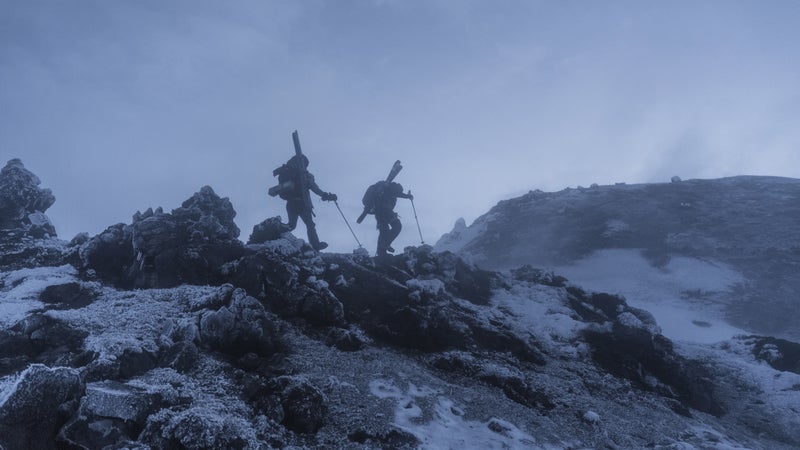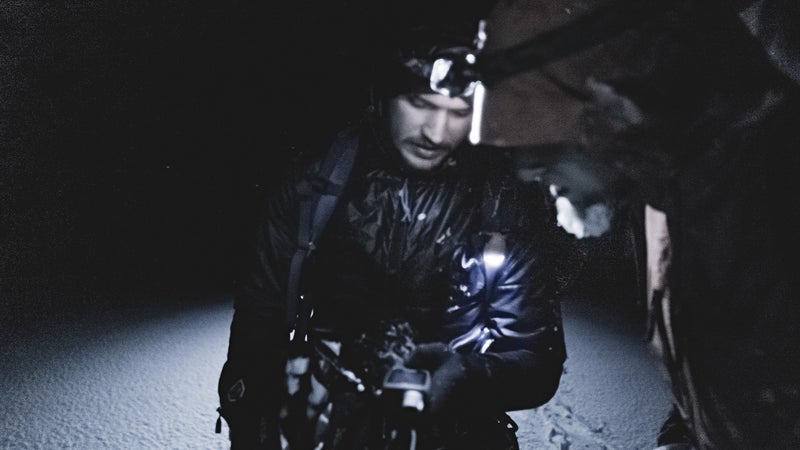Is Social Media Screwing Over Explorers?
Young, tech-savvy adventurers are taking sponsors and funding away from grizzled, old-school explorers who aren’t strong on Facebook and Twitter. But they don’t always pull off the awesome feats they say they will.
New perk: Easily find new routes and hidden gems, upcoming running events, and more near you. Your weekly Local Running Newsletter has everything you need to lace up! .
On December 3, 2015, four friends from the UK, ages 19 and 20, set out to cross Iceland on lightweight alpine-touring skis, without support. You may have heard about them: a series of setbacks and two monster storms doomed their attempt, and the team accepted a helicopter rescue from the Icelandic Association for Search and Rescue, known as ICE-SAR, ending the trip well short of the goal. Cold and soaking wet, the four young men and American filmmakers Renan Ozturk and Taylor Rees, who joined for parts of the expedition, were flown 100 miles from a hut in the gravely hills on the southern part of the island to Reykjavik on December 29.
After the evacuation, the four Brits were skewered as irresponsible and cocksure by Icelanders and media outlets around the world. “Grand ambition is no substitute for common sense,” read . Three people sent the team death threats. Rees recalled a local man confronting the Brits in a Reykjavik coffee shop after their evacuation. “What the fuck are you guys doing?” he snarled. “Leave already!”
Although the team members lacked experience on big expeditions, they compensated with social media and marketing savvy befriending seasoned professionals like based in Dubai, in the process. They dubbed the expedition the “Coldest Crossing” and put together an extensive media kit detailing their plans. Team leader Charlie Smith that looks as slick as any you’ll see in the outdoor industry. They had a filmmaker friend cut together a about their trip using footage from a five-day training hike through Iceland they’d done last summer.
Two months before the expedition, Smith sent Rees the trailer on Facebook to get her thoughts. She had never heard of the Brits or their plan, but their objective and glossy presentation intrigued her. She and Ozturk happened to have a block of free time in December, so they signed on to document the expedition. “Part of the reason Renan and I committed was, ‘Wow, first winter crossing of Iceland, that’s pretty unique,’” Rees says.
Have we reached a point where it is more important for adventurers to be shrewd with presentation than proven in hardcore mountain environments?
At least, the group’s website and film trailer claimed the Brits would be “the first to cross Iceland unsupported in winter.” In fact, a handful of other adventurers had completed unsupported crossings of their own—east to west, diagonally, and north to south—the earliest ones dating back nearly a century. Smith later told ���ϳԹ��� that the team aimed to be the first to traverse the island country “from the northernmost point to the southernmost point,” unsupported, in winter. That was always their plan, he said, even if the key distinction wasn’t clear before the expedition.
By then, the Brits had cultivated such a buzz that big-time sponsors, including Fjällräven and Atomic, were approaching them with offers to contribute. Ozturk and Rees were behind them. News outlets were running articles. The outside support and interest did two things: legitimized the expedition and created a tower of expectations. The young men tried not to let the hype affect them.
“The initial and main reason we were there was to inspire young people to go [outdoors] and try something,” Smith says. “At the end of the day, if I didn’t think we were up to the challenge, we wouldn’t have tried it.”
For many adventurers and explorers, drumming up media interest, securing sponsors, and attracting funding is the hardest part of pulling off an expedition. The physical part is what they’ve trained for their whole careers. The Brits, by comparison, approached their expedition in reverse. “They were extremely well researched,” Ozturk said. “They just don’t have some of the sixth sense that comes from doing this stuff over a lifetime, and that’s not their fault. A big point of the trip was for them to go out in the world and find that.”
The failed expedition and vitriolic public reactions that followed raised broad questions about the makings of an explorer in the 21st century, and the evolving mechanics of the adventure industry. Authenticity and ambition used to go hand in hand on professional expeditions. Now, some wonder whether authenticity has been usurped by accessibility—the need to invite the world aboard, or risk being left at home. “They might want to think about just having fun adventures for themselves, not somebody else,” wrote Icelandic Alpine Club member Sveinn Sveinsson in a of the trip. Perhaps the most significant question is this: Have we reached a point where it is more important for adventurers to be shrewd with presentation than proven in hardcore environments?

As recently as ten years ago, major underwriters and sponsors would vet expeditions primarily according to their potential to make history, either by exploring a new area or pursuing a first ascent or first descent. Ambitious objectives dating all the way back to 1963, when an Eddie Bauer-backed American team attempted (and completed) a first ascent of Everest’s West Ridge, came with uncertainty—in fact, that was part of the appeal.
“If there’s no risk of failure, then it’s not a real story” was the prevailing attitude, says Scott Willson, who spent a decade as the photo and video editor at the North Face and six more years as photo editor at Patagonia.
Before Willson left the North Face two years ago, he served on the company’s expedition committee and helped select the trips the company funded. Once a year, he and a group of others sat in a room and evaluated 75 to 100 proposals, eventually selecting between eight and 15 to fund. At least a handful of trips proposed something “purely exploratory, to the point where if we got no content at all, it would be okay,” Willson says.
In recent years, however, with the rapid advancement of storytelling technology—high-definition DLSRs, action cameras, even smartphones—as well as the ability to edit in the field and the power of social media as an advertising platform, the selection criteria has changed dramatically, Willson says. The ability to distribute content—photos, videos, blogs, tweets—in real-time has offset the need for a high-risk story after the fact, at least in terms of reaching an audience.
“There was a conscious decision to flip that formula, to start with, ‘What do we need on Facebook and Twitter? What do we need for the retail stores so they can be talking about this?’” Willson says. “You’re given this laundry list of stuff, and a story that can provide more information along the way, yeah, it has a lot of value.”
Willson remembers a 2009 deepwater soloing trip to Mallorca involving climbers Alex Honnold, Emily Harrington, Cedar Wright, James Pearson, and Matt Segal. The athletes rented a house and blogged throughout the trip, often posting video dispatches that Wright edited on the fly. “It wasn’t a lightweight trip at all, but it really was more of a photo shoot” than a cutting-edge expedition, Willson says. He pauses, then adds: “It provided a lot of great content.”
“My opinion is that most brands just want content,” Ueli Steck says. “They don’t care about performance. Which I think is very bad for the sport.”
Trips that cost upwards of $100,000, don’t offer that same potential for real-time updates, and have a higher probability of failure are becoming rarer, despite their potential to produce historic feats and stories, Willson says.
In fact, one of the few recent expeditions to strike a successful balance was the first ascent of Mount Meru’s Shark Fin by Conrad Anker, Jimmy Chin, and Ozturk, in 2011—another North Face sponsored trip. During team’s first attempt, in 2008, the men turned back just 500 feet below the summit after 19 days on the route, having been pinned by a storm and forced to ration their food. Still, the North Face green-lighted the climbers’ second attempt three years later, and they succeeded. (Anker had also tried in 2003 with different partners.) The two journeys became the basis of last year’s award-winning documentary, Meru, which reminded the industry how audacious expeditions can be, even when their stories are told years later.
Highly specialized trips like the ascent up Meru cost a lot of money, but there are also few people in the world who can even attempt such objectives. The rest of the time, sponsors can drum up just as much social media currency without spending nearly as much money.
Willson understands why the priorities have shifted in recent years, but he wonders if social media mandates—say, requiring three publishable images per week via satellite transmission—dilute the material’s impact as a whole. “It’s like you’ve taken all this emotion away from this beautiful stuff,” he says. “Now it’s just content to fill buckets.”

Andrew McLean finds himself on the wrong side of the shift. As one of the leading ski mountaineers of the past 50 years, McLean has built a reputation for exploring exotic zones and making first descents on all seven continents. This winter, however, two of his sponsors—Backcountry.com and Mountain Hardwear—dropped him. He wasn’t alone: Mountain Hardwear also dropped a total of 13 of its 20 sponsored athletes, including renowned Swiss alpinist Ueli Steck.
McLean, who just turned 55, used to get an expedition allowance, a gear allowance, and a stipend for sponsor obligations around the country. He travels frugally: this year, he tried to find sponsorship for an exploratory ski trip to the Kamchatka Peninsula in eastern Russia that would cost $3,600—flight, food, and in-country travel included. Not only could he not secure funds, he couldn’t find anyone with enough sponsor support to join him on the trip. Instead, he settled on a $300 trip to explore the Ruby Mountains in Nevada, just 280 miles from his home in Utah.
McLean, admittedly, is not great with social media. “Entering text on the phone, I just don’t have the patience for it,” he says. And he knows it cuts into his opportunities, regardless of his experience and skills. “If the sponsor’s goal is to get exposure, then having someone get 12,000 likes for exploring out of bounds at a ski resort versus 200 likes for putting a new line up K2 is almost a no-brainer,” McLean says.
Steck, who concedes that he is “not a marketing person,” shares McLean’s view. “My opinion is that most brands just want content,” he says. “They don’t care about performance. Which I think is very bad for the sport.”
Mountain Hardwear brand manager Kari Rice says the reason the company cut its athlete team so drastically was to focus on those who tell stories “that resonate with an average outdoor user.” When asked why an up-and-coming climber like 25-year-old Yosemite big-wall stud Cheyne Lempe would be selected for the team over a global name like Steck, Rice said Lempe is more willing to share the human side of his adventures—even the failures.
“We need to remind young people that they can act independently of sponsorship and social media and still have valid experiences—and allow them to make mistakes.”
“You rarely hear these stories about people questioning their place and whether they should be there,” Rice says. Those stories, she says, have more value now than ever before. Brands are increasingly conceding layers of invincibility for opportunities to remind consumers that pros, too, get cold and scared on their adventures. “The industry, for a long time, was really focused on the summit,” Rice says. “While we love hardcore alpinists, and alpinism is so important to our brand, what we really love are the athletes who can connect to people who are never going to go to that summit.”
To fill the void left by a smaller global athlete team, Mountain Hardwear relies on a roster of 50 “ambassadors” around the world—relatively anonymous yet gung-ho adventurers who are selected from a pool of applicants in no small part due to their social-media reach. They are paid in free gear and required to promote the brand on various social channels. Perhaps the biggest perk, however, is they can pitch trips—from continental adventures to overseas expeditions—to be funded by Mountain Hardwear.
Steck, who is attempting a new route on 26,289-foot Shishapangma this spring in Tibet, remains dubious about the ambassadors’ role and questions whether putting so much stock in social media is worthwhile. “I don’t know if it’s possible to create a good image for a brand with daily Facebook posts where the athlete just eats his breakfast or goes climbing for a bit.”
That’s not to say there aren’t benefits of seeing approachable expeditions in our social media streams.
“I do think we have a responsibility to encourage adventure for the sake of adventure,” says polar explorer Eric Larsen. “We need to remind young people that they can act independently of sponsorship and social media and still have valid experiences—and allow them to make mistakes.”
This is why when someone asks Larsen how to do what he does, he always gives the same advice: don’t get sponsored right away. “I think people put the cart before the horse and see sponsorship as a way in,” he says. In Larsen’s case, by the time he planned his first polar expedition, in 2005, he had 10 years of experience organizing and undertaking international trips. Once sponsors get involved, and hype builds, Larsen says, “there’s not a lot of room for mediocrity.”
Larsen followed the saga of the Coldest Crossing from Antarctica. He, like many, admired the young men’s pluck and persistence. (He also complimented their website.) But he stopped short of regaling them. “The reason there was backlash was because they made a false claim,” he says simply.
Evaluating the trip six weeks after it ended, Smith is measured. “People with more experience have done insanely great things and succeeded,” he says. “But they’ve also had a lot worse outcomes than what we had.”
“I think what we admired in them is that they kept going,” Rees says. “I have three teenage brothers, and I want them to go do some crazy stuff. I don’t want them to put themselves or other people at risk, but it’s sad to see people saying, ‘I can’t do anything bold because I’m not Bear Grylls.’”
Ozturk, a veteran of more than 20 international expeditions, defends the Brits: “I think what they were attempting was much harder and more complicated and took more personal responsibility than some sensationalized climb of Everest, like the next youngest person to climb it. Those kids don’t do much, they just sit in their tent and get out and clip onto the fixed ropes of the Sherpas.”
For all the scorn the Coldest Crossing team members received, they fit somewhere between the audacious explorers of old and the greener aspirants we see in our social media streams today. Pitching sponsors on a lofty goal and the promise to bring the world along for the journey is the way these types of ventures are approved—for the seasoned and inexperienced alike. The balance of authenticity and accessibility has shifted in the Brits’ favor, and they took advantage. To focus on their failure is to ignore a fundamental truth of exploration: it’s a gamble on the unknown.
“We were there for an adventure,” Smith says. “And you can say now, we definitely had one.”


